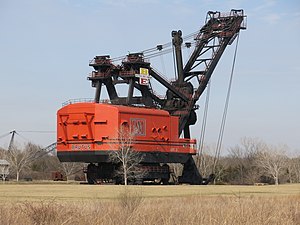Big Brutus
 Big Brutus in 2014 | |
| Class overview | |
|---|---|
| Name | Big Brutus (1963-Present) |
| Builders | Bucyrus-Erie |
| Operators | |
| Succeeded by | Model 1950-B-series Electric power shovel |
| Cost | US$6.5 million (1987) [1] |
| In service | 1963-1974 |
| Planned | 1 |
| Completed | 1 |
| Preserved | 1 |
| History | |
| United States | |
| Name | Big Brutus |
| Builder | Bucyrus-Erie |
| Launched | 1962[1] |
| Christened | May 1963 |
| Commissioned | May 1963 |
| Fate |
|
| Notes | Largest power shovel preserved |
| General characteristics | |
| Class and type | Model 1850-B-series Electric power shovel |
| Tonnage | 4,200 t (9,260,000 lb) + 770 t (1,700,000 lb) ballast when operational |
| Length |
|
| Beam | 18 m (59 ft) |
| Height | 48.8 m (160 ft) (to tip of boom) |
| Installed power |
|
| Propulsion | 8 x caterpillar tracks |
| Speed | 0.22 mph (19 ft/min) (5.8m/min) max |
| Capacity | Blade capacity: 90 cubic yards (68.8 m3) or 150 short tons (140 t) |
| Complement | 3[1] |
Big Brutus | |
| Built | 1963 |
|---|---|
| NRHP reference No. | 100001945 |
| Added to NRHP | January 5, 2018 |

Big Brutus is the nickname of the Bucyrus-Erie model 1850-B electric shovel, which was the second largest of its type in operation in the 1960s and 1970s. Big Brutus is the centerpiece of a mining museum in West Mineral, Kansas, United States, where it was used in coal strip mining operations. The shovel was designed to dig from 20 to 69 feet (6.1 to 21.0 m)[1] down to unearth relatively shallow coal seams, which would then be mined with smaller equipment.
Description
The fabrication of Big Brutus was completed in May 1963, after which it was shipped on 150 railroad cars to be assembled in Kansas. It operated until 1974, when coal was uneconomic to mine at the site. At that time, it was considered too big to move and was left in place.
Big Brutus, while not the largest electric shovel ever built, is the largest electric shovel still in existence. The Captain, at 28 million pounds (13 kt) – triple that of Big Brutus – was the largest shovel and one of the largest land-based mobile machines ever built, only exceeded by some dragline and bucket-wheel excavators. It was scrapped in 1992, after receiving extreme damage from an hours-long internal fire.[3]
Museum
The Pittsburg & Midway Coal Mining Company donated Big Brutus in 1984 as the core of a mining museum which opened in 1985. In 1987, the American Society of Mechanical Engineers designated Big Brutus a Regional Historic Mechanical Engineering Landmark.[4] It was listed on the National Register of Historic Places in 2018.
The museum offers tours and camping.
Fatal accident
On January 16, 2010, Mark Mosley, a 49-year-old dentist from Lowell, Arkansas, died attempting to base-jump from the top of the boom. Climbing the boom had been prohibited years earlier; after the accident, the attraction's board of directors considered additional restrictions on climbing.[5] During the accident's investigation, examiner Tom Dolphin determined that Mosley had accidentally fallen off the boom while preparing to jump.[6]
See also
- The Silver Spade
- Bucket wheel excavator
- Dragline
- Dump truck
- Excavator
- Marion Power Shovel
- Power shovel
- National Register of Historic Places listings in Cherokee County, Kansas
References
- ^ a b c d e "Archived copy" (PDF). Archived from the original (PDF) on 2010-07-03. Retrieved 2010-03-26.
{{cite web}}: CS1 maint: archived copy as title (link) - ^ "Big Brutus". October 4, 2022.
- ^ Haddock, Keith (September 18, 2000). Colossal Earthmovers. MBI. pp. 67. ISBN 978-0-7603-0771-7.
- ^ "About Big Brutus". Big Brutus, Inc. Retrieved 2009-07-19.
- ^ Younker, Emily (18 January 2010). "Co-worker: Base jumper no novice". Joplin Globe. Retrieved 22 November 2020.
- ^ "Report: Parachute worked". Arkansas Democrat-Gazette. February 11, 2010. Retrieved September 3, 2021.
